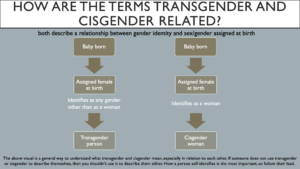We are trying to create a culture change at Mason. To respect transgender and gender nonconforming students, we need to do many things across campus. Not everything is under our control as different units and departments at Mason, but we can make decisions about some things that could make a world of difference for the students with whom we interact.
Pronouns are a great place to start.
Before you can use pronouns– you need to know how– if you are unsure, please look at this usage chart from Trans Student Educational Resources (TSER) here. Asking about pronouns works best when everyone does it, so start with your own if you are going to ask one or more person’s pronouns.
One way to encourage the use of pronouns with introductions is to include a space for pronouns on your name tags. We ordered Avery 5395 adhesive name tags, used one of the Avery online templates to add in the pronoun option, walked the name tags to Print Services, and submitted an online order through their digital store front. If you want to use our template, it is linked here in PDF format (which Print Services has used already), just make sure you bring them the Avery 5395 adhesive name tags to make it work.
Another easy way to include pronouns is to add them to your email signature if you are comfortable doing so. The presence of your pronouns at the bottom of your email can communicate to students that you are open to hearing their pronouns instead of assuming and helps everyone else to use the correct pronouns with which to refer to you.
Additional Information
Frequently, people conflate or confuse sexual and/or romantic orientation, gender identity, gender expression, and sex assigned at birth, but they are separate and uncorrelated: click for the gender unicorn, also from TSER, to see a visual representation of these spectrums.
Using the word cisgender helps to destabilize the idea of cisgender people being normal as opposed to “not normal” transgender people.



